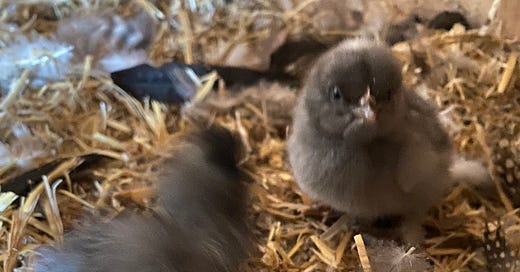Seeing cute babies activates a primal part of our brains, releasing serotonin and bringing up feelings of love and our nurturing instincts. There's a reason that baby animal videos are some of the most watched and one of the few genres of internet content consumption associated with increased mental health wellness rather than the opposite.
But even better than watching videos of cute baby animals is when they appear live in our yard. Such was the case with Fluff Nugget, who had been diligently incubating her eggs (to her own detriment) for the 21-day vigil required to hatch some babies. My older son named Fluff Nugget because: "she's fluffy and shaped like a nugget."
Fluff Nugget is large, puffy, and a stunning blue-slate color. She boasts impressive fluff from her head all the way down her legs - more like a muppet than a living being. Of the seven eggs she was incubating, five hatched, and each baby was her tiny clone. The babies have all Fluff Nugget's cuteness but distilled into a chick-sized singularity. Their cuteness is so dense they might create their own tiny black holes.
As they orbit around their mother like little cute fuzzy moons, learning how to chicken, the chicks unknowingly possess a gravity - I swear the other chickens all stop to admire them. I've even caught my husband, who has grown impervious to the charms of the animals, sneaking out of his office between meetings just to watch the little blue fuzz balls bounce about.
Although the cuteness seems to brighten each of my days, it turns out that it serves more than an aesthetic purpose.
In 1949, the psychologist, ornithologist, and zoologist Konrad Lorenz argued cuteness is an evolutionary trait babies possess to trigger adult nurturing responses. He claimed that better parenting ensures the survival of a species - which makes sense. In many cases, the more adult intervention a baby needs to survive, the "cuter" it will be. Humans are chief among the helpless-baby species.
The cuteness of babies as an adaption theory is a chicken and the egg question (to coin a phrase). Are babies born or hatched cute to trigger a response in adults? Or are adult brains wired to care for small things with big eyes to ensure our survival? Either way, subsequent scientific study has provided further evidence for Lorenz's theory.
Lorenz, as an ornithologist, spent most of his bird-time studying geese, authoring several papers on “imprinting” - the idea that baby birds believe the first big moving thing they see is their mother. Geese are similar to chickens - if chickens were possessed by the Devil, given cobra necks, sharp stabbies all around their mouths and tongues, and a penchant for biting everything in a six-foot radius. But, at least baby goslings are cute, too.
So, I'll probably sneak out later to watch the little mini-Fluff Nuggets bop about the coop. I'll take all those intoxicating nurturing instincts flooding my brain as I watch those huge eyes peer back at me through the gray fluff, and I'll remember once again, as always, that life is basically a miracle.
If you don’t have chicks peeping around, it’s ok to watch those baby animal videos, it’s good for your mental health.








Share this post